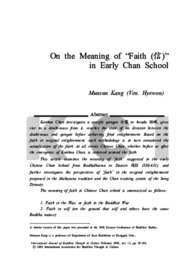

PARTNER
검증된 파트너 제휴사 자료
On the Meaning of “Faith (信)” in Early Chan School
한국학술지에서 제공하는 국내 최고 수준의 학술 데이터베이스를 통해 다양한 논문과 학술지 정보를 만나보세요.
14 페이지
최초등록일 2025.05.31
최종저작일
2009.02

-
미리보기
서지정보
· 발행기관 : 동국대학교 불교학술원
· 수록지 정보 : International Journal of Buddhist Thought and Culture / 12권 / 95 ~ 108페이지
· 저자명 : 강문선
초록
Kanhua Chan investigates a specific gongan 公案 or hwadu 話頭, gives
rise to a doubt-mass from it, reaches the state of no division between the
doubt-mass and gongan before achieving final enlightenment. Based on the
faith in original enlightenment, such methodology is in turn considered the
actualization of the faith. At all events Chinese Chan, whether before or after
the emergence of Kanhua Chan, is centered around the faith.
This article examines the meaning of ‘faith’ suggested in the early
Chinese Chan School from Bodhidharma to Daoxin 道信 (580-651), and
further investigates the perspectives of ‘faith’ in the original enlightenment
proposed in the Mahayana tradition and the Chan training system of the Song
Dynasty.
The meaning of faith in Chinese Chan school is summarized as follows:
1. Faith in the Way, or faith in the Buddhist Way
2. Faith in self (on the ground that self and others have the same
Buddha nature)
3. Faith in the sitting meditation (three prerequisites for the training of
Kanhua Chan)
4. Faith in the Buddhas and patriarchs
Since Kanhua Chan takes the view of actualizing enlightenment rather
than original enlightenment, it may seem to develop from faith to practice,
and then to actualization by stages; but ultimately it is an attempt to acquire
self-faith through a gongan. The faith put forward in Kanhua Chan involves
doubt (or a thorough self-criticism), which is in turn derived from the faith.
From the standpoint of Kanhua Chan, the faith suggested by the early
Chan masters like Bodhidharma involves the idea of sudden enlightenment,
while in Kanhua Chan that is used as the confidence or belief in the
doctrine, showing similarities to that of early Buddhism.참고자료
· 없음태그
-
자주묻는질문의 답변을 확인해 주세요

꼭 알아주세요
-
자료의 정보 및 내용의 진실성에 대하여 해피캠퍼스는 보증하지 않으며, 해당 정보 및 게시물 저작권과 기타 법적 책임은 자료 등록자에게 있습니다.
자료 및 게시물 내용의 불법적 이용, 무단 전재∙배포는 금지되어 있습니다.
저작권침해, 명예훼손 등 분쟁 요소 발견 시 고객센터의 저작권침해 신고센터를 이용해 주시기 바랍니다. -
해피캠퍼스는 구매자와 판매자 모두가 만족하는 서비스가 되도록 노력하고 있으며, 아래의 4가지 자료환불 조건을 꼭 확인해주시기 바랍니다.
파일오류 중복자료 저작권 없음 설명과 실제 내용 불일치 파일의 다운로드가 제대로 되지 않거나 파일형식에 맞는 프로그램으로 정상 작동하지 않는 경우 다른 자료와 70% 이상 내용이 일치하는 경우 (중복임을 확인할 수 있는 근거 필요함) 인터넷의 다른 사이트, 연구기관, 학교, 서적 등의 자료를 도용한 경우 자료의 설명과 실제 자료의 내용이 일치하지 않는 경우
문서 초안을 생성해주는 EasyAI
